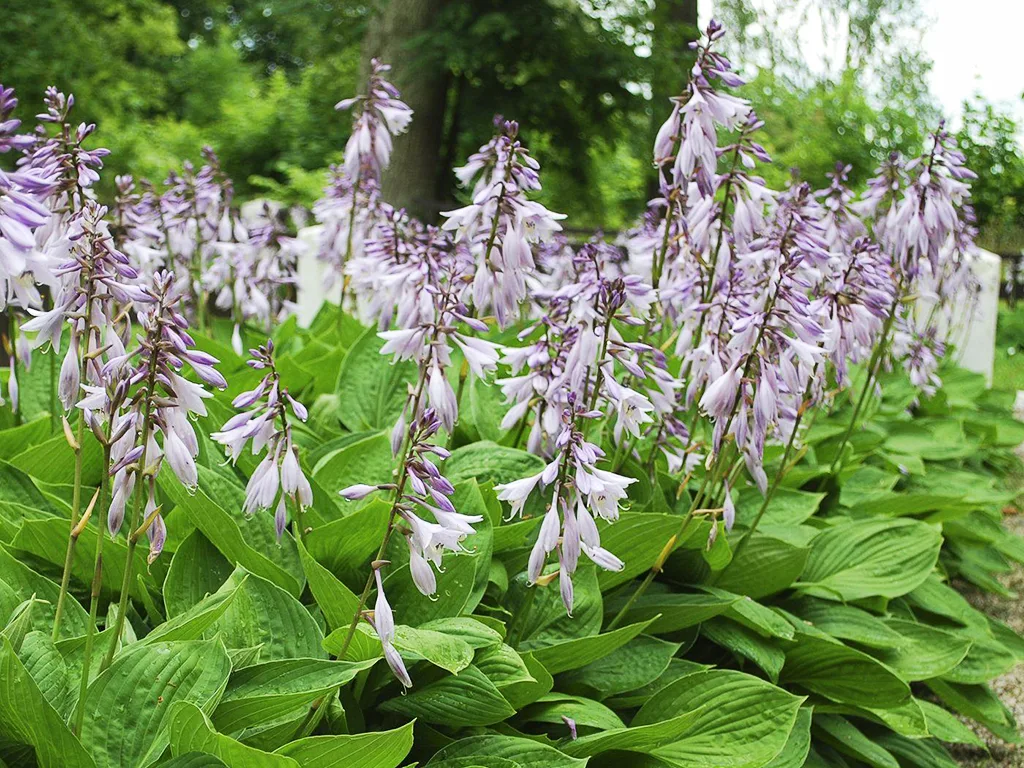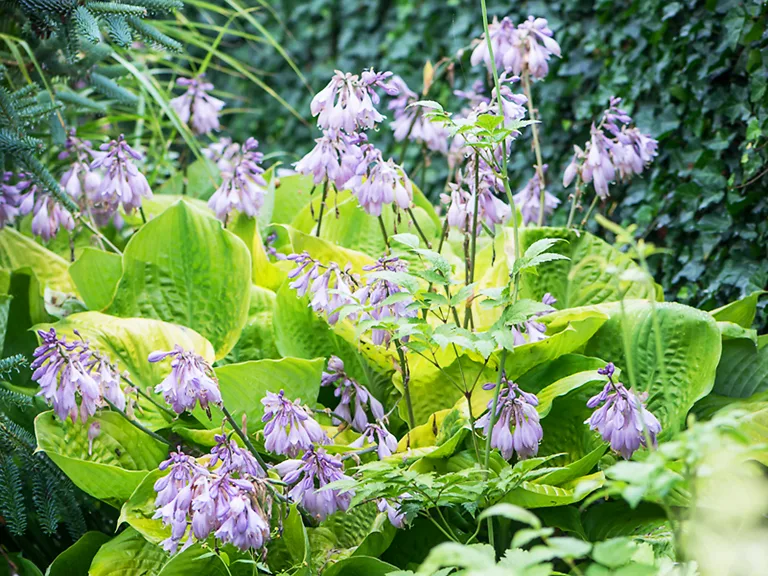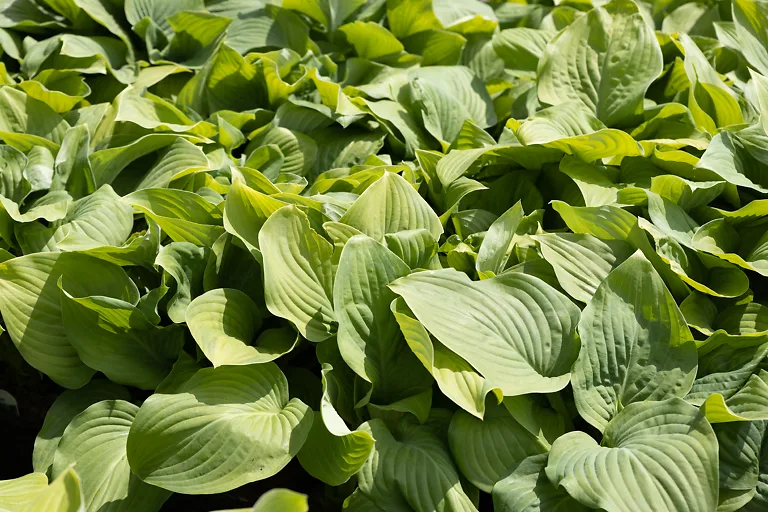
Written by s • Tardiana Hosta and Friends
When confronted with the roughly 10,000 different hosta varieties available, the best way to understand them better, and so be able to choose and use them in your garden better, is to put them in groups. For many plants that means tracing them back to the original wild species they came from, but that is especially tricky with Hosta, for reasons we will see. At first glance you might think this kind of analysis is boring, complicated and of no practical use, but here is the thing. Just like the revelation of realizing its easier to eat soup with spoon than a fork, having some order and organization of a group of plants is like entering a new world. Suddenly it all falls into place, and what was random chaos becomes easy and organized – like sorting out those piles of books you have been meaning to get to for a while now. Plus, the history of these things is fascinating, and great garden-party conversation!
We can’t do that in one go with all the Hosta, there are just so many, so let’s pick one group and tell their story – the story of a group of hosta that today we call the Tardiana Group. A story filled with fascinating characters and back stories that will enrich your gardening experience, make plants more real and more enjoyable to you, and help you become better at laying out your plants and creating attractive gardens.
Features of Tardiana Group Hostas
Tardiana Hosta varieties combine the blue-green leaf coloring found in plants derived from Hosta sieboldiana, with the unusual narrower, pointed leaves, held horizontally, of Hosta tardiflora. The result is a range of small to medium-sized plants with different levels of blueness on the leaves, ideal where the larger blue hostas won’t fit in. The narrower leaves and elegant form makes them among the most beautiful of hostas, adding foliage variety to shady beds. Because Hosta tardiflora keep growing and blooming later than other species, these plants also keep looking good in the garden in fall, when other hosta are collapsing at the first cold night. Some people have even suggested that it could be possible to create the first evergreen hosta from them. Where you want a smaller blue hosta, the Tardiana Group is where to start.
The First Plants from Asia
The larger story of how so many of our most popular plants came to Europe and America is too large to tell here, but there are a couple of key take-aways. Japan in particular was very strict about the arrival of foreigners, and only allowed them to come at all under very strict conditions. They had to live in one of a handful of trading posts, on islands or in some other way isolated. They could only work through a handful of local translators, and were usually forbidden from traveling freely. Trade was the only purpose allowed, but the Japanese soon realized that Western medicine was more effective than their own, so Western doctors could often get special favors.
Back in those days, the 18th and 19th centuries, it was common for a doctor to also be a naturalist, someone interested in birds, animals, and plants. The desire to discover and describe the natural world was strong in those times, and new plants had incredible value. But if you couldn’t travel, where to find them?
The Japanese were very advanced in gardening, and had nurseries to reproduce and sell unusual varieties of their wild plants for gardens. So one way to simply buy them. As well, you could hire someone to go collecting for you, but they might decide that was too hard, and pick up something at the local garden-center instead, telling you it was wild.
Being a collector of new plants helped your social status, and going away for years on a dangerous adventure, only to come home with something from Home Depot, wasn’t great, so even if you knew, you likely wouldn’t say. Anyway, it wasn’t a distinction with much meaning back in those days.
As a result, lots of new plants were labelled as exciting new species, even though later, after further visits by others, it was realized they weren’t. This has happened with lots of our plants, and it happened with hostas too. Let’s set the stage for the Tardiana hosta by looking at its parents.
Hosta sieboldiana
This plant was one of the first brought to the West, by exactly the kind of person we have been talking about. Philipp Franz von Siebold was a German doctor who worked for the Dutch, one of the few countries Japan let in at all. He was also a keep botanist, and wrote a major book on Japanese plants. In 1862 he sent a plant to Europe which later was named after him as Hosta sieboldiana. Today we realize it was never a wild species (Home Depot, Tokyo?) and so we should more correctly call it Hosta ‘Sieboldiana’.
In 1905 the German nurseryman Georg Arends, famous for his Arendsii Astilbes, crossed his plant of von Siebold’s hosta with another Japanese species, Hosta tokudama (now Hosta ‘Tokudama’ for the same reasons), that came to Europe around the same time from the British collector Robert Fortune. The resulting hybrid plant was called ‘Elegans’, and when hostas first became more popular in the first half of the last century, it was the ‘big, blue-leaf hosta’ that everyone grew.
Hosta tardiflora
This is another Japanese plant that has been ‘re-written’ based on later knowledge. It didn’t come from one of the famous collectors, but it seems to have been a slightly unusual seedling of a truly wild plant called Hosta longipes var. lancea, found in a small area of the mountains of Japan. It is a small plant with unusually narrow and pointed leaves for a hosta. Today we should call it Hosta ‘Tardiflora’, which refers to how late (‘tardy’) it is in flowering, usually only in fall.
Eric Smith and Hadspen House
Now we come to the heart of our story. The time-line of Eric Smith’s life has become a bit confused, but he was certainly one of England’s most dedicated and important plant enthusiasts of the last century. Trained as an architect he fell in love with plants, and dedicated himself to them, and to breeding them. He worked in the early 1960s for a time at Hilliers Nursery, a famous British propagator of rare trees and shrubs, although Eric was in their perennials nursery. There he created many hybrids of perennials, including a Hellebore named after him, Helleborus x ericsmithii. Then he started a nursery with another plant enthusiast, the alpine plant specialist J. C. (“Jim”) Archibald. Together they opened ‘The Plantsmen’, at Buckshaw House, Sherborne, Somerset, offering rare and unusual perennials and plants from Jim’s collections from different mountain ranges and Eric’s breeding. Jim was the wealthier man, and it seems he wanted to give Eric Smith a place to use his talents. The business was successful at first, thanks to Jim’s business skills, but ultimately failed after an unsuccessful merger with a larger nursery. In 1975 (the timing is fuzzy) Eric moved to Somerset, to Hapsden House, home of Penelope Hobhouse, famous for her books on gardening and garden design. It seems to have a job where he was part gardener, part nursery operator, and part breeder, left pretty much to his own devises.
Earlier, Eric had the chance to do something unusual, and he took it. He grew both Hosta sieboldiana ‘Elegans’ and Hosta tardiflora, but they flowered at different times, so he couldn’t cross them together, with the aim of producing a smaller hosta with blue leaves. In 1961, though, ‘Elegans’ sent up some late flower stalks, and he took the opportunity to cross them together. the resulting plant, named by combining the names of the two parent species (the rule for such things) became Hosta x tardiana. Today, since those plants are not ‘real’ species anymore, the plants from this cross are called Tardiana Group Hostas. Eric raised just 5 seedlings from his cross, and Eric and Jim selected one, calling it ‘Halcyon’, perhaps thinking back to the happy times when they innocently started their business (see picture at top). Probably using seeds from ‘Halcyon’, thousands of seedlings were raised, and the best selected.
When Eric Smith moved to Hadspen House he took with him his plants from Buckshaw, and they were subsequently released as a series, all containing the name ‘Hadspen’, for example, ‘Hadspen Blue’, perhaps the bluest hosta of them all. Various enthusiasts and organizations gradually registered many of his plants, so that today there are 74 varieties attributed to him, often named after Hadspen, Buckshaw, Sherborne, or simply, ‘Blue (something)’. Most are listed as ‘origin unknown’, since no-one has been able to trace exactly what Eric Smith did to create most of them. He created the foundation of the Tardiana Group hostas, and those originals, especially ‘Halcyon, can be found in the background of just about every blue hosta around today.







